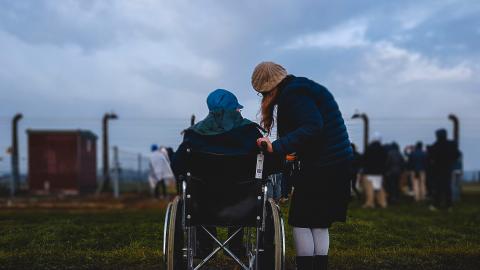Together, We Create Disability
1 comment
95 views

What is a disability?
It seems like the answer is obvious to most people. A disability is a moderate to severe long-term impairment. Macular degeneration is a disability, but near-sightedness is not because it can be corrected with glasses. Having trouble walking is a disability, but being clumsy is not. Having an IQ of 60 is a disability, but having an IQ of 90 is not.
It seems obvious, but the trouble with thinking of disability this way, is that it is all located in the person who has the disability. In this way of thinking, disability is a medical problem of some kind which should be treated and the person living with the disability needs to be rehabilitated.
The trouble with this way of thinking is this: it ignores our collective participation in disability.
For this reason, when the United Nations described disability in their Convention on the rights of persons with disabilities, the authors recognized that society takes part in disabling people. The first half of the definition recognizes that disabilities are impairments, but the second half points out that the impairments confront barriers in society: “Persons with disabilities include those who have long-term physical, mental, intellectual or sensory impairments which in interaction with various barriers may hinder their full and effective participation in society on an equal basis with others.” (Article 1: Purpose, “Final report of the Ad Hoc Committee on a Comprehensive and Integral International Convention on the Protection and Promotion of the Rights and Dignity of Persons with Disabilities,” United Nations General Assembly, A/61/611, 6 December 2006)
It’s those barriers that we together create that cause problems of accessibility for people with disabilities, barriers of architecture, communication, and attitude. For example, buildings are constructed with the assumption that people can climb steps. So most buildings have steps. Those steps disable anyone who cannot use steps, keeping them from entering or using the building.
Another example, employers discriminate against people with disabilities on a regular basis. If two people are equally qualified for a job, one who has a disability and another who does not, employers consistently hire the non-disabled person. For this reason, the unemployment rate of people who are blind or severely visually impaired is around 50 percent, much worse than the national unemployment rate. (The unemployment rate is probably much higher for people with other disabilities too, but I don’t have statistics for those.)
In describing the portrayal of people with disabilities in film, Marten F. Norden, noted that by the early 1980’s although much scholarly attention had been devoted to media-stereotyping of various subgroups of society such as women and African Americans, no such attention was paid to stereotyping of people with disabilities. He considers the reason for this lack,
“I remember thinking that this lack of scholarly attention could probably be attributed to the long-standing belief among able-bodied society members that disability is primarily an individualistic, medically defined problem, not a socially constructed one. In other words, they believed (and no doubt, some still do) that society bears little if any responsibility for a disabled person’s struggles; it all rests squarely on the shoulders of that person.” (“The Hollywood Discourse on Disability: Some Personal Reflections,” Screening Disability: Essays on Cinema and Disability, edited by Christopher R. Smit and Anthony Enns, University Press of American, 2001)
Sadly, it’s not always better when people with disabilities come to church. Many, though not nearly all, congregations have invested in renovating their facilities to make them more accessible to people with disabilities.
However, attitudes are much more difficult to renovate. One time I led a workshop. One of the participants said that he had a friend who had been active in his church, and then the friend had a stroke. Although he still had much to contribute after the stroke, the church wouldn’t recognize that. This man in my workshop said that his friend told him, “I feel like I’ve been put on the shelf.” Fellow church members set him aside because they decided that his limitations after the stroke kept him from ministering in any way.
The church members may have thought that the man was sidelined by this stroke. They didn’t see, maybe they didn’t want to see, that they also participated in sidelining him.
Together, we create disability. Once we recognize and admit to our participation in other people’s disability, we can begin to remove the barriers to participation that we have erected.
Disability Concerns, Church Admin & Finance
Disability Concerns, Church Admin & Finance
Disability Concerns, Training and Education
Disability Concerns
Connect to The Network and add your own question, blog, resource, or job.
Add Your Post
Comments
Very true, without knowing they are sometimes.
Let's Discuss
We love your comments! Thank you for helping us uphold the Community Guidelines to make this an encouraging and respectful community for everyone.